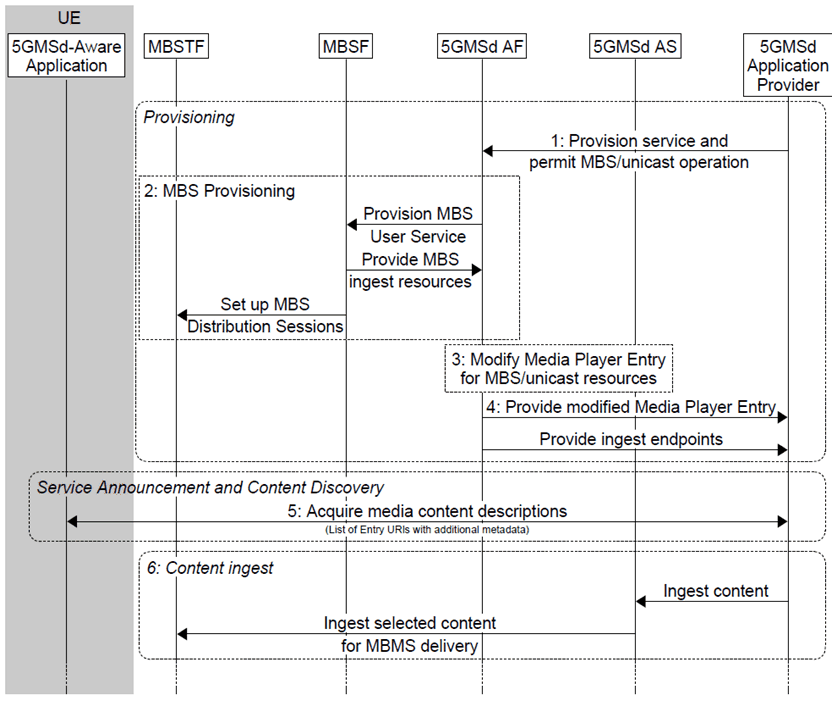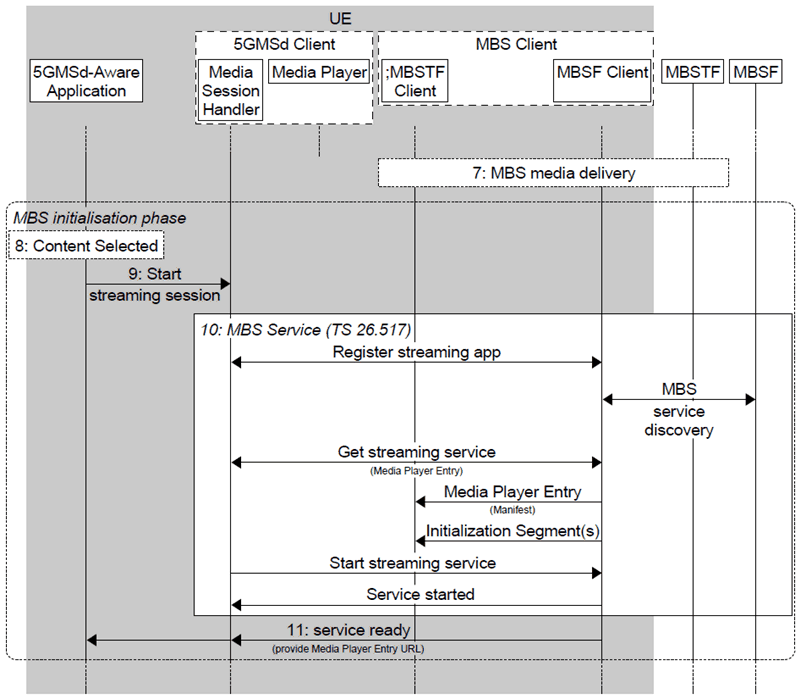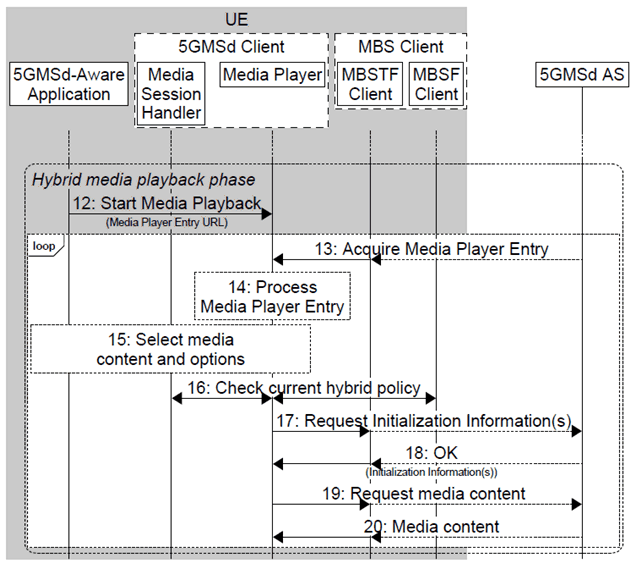Content for TS 26.501 Word version: 18.6.0
1…
4…
4.0.6…
4.1…
4.2…
4.2.2…
4.3…
4.4
4.5…
4.6…
4.7…
4.7.4…
4.8
4.9…
4.10…
5…
5.2…
5.2.4
5.2.5…
5.3…
5.3.2…
5.4…
5.5…
5.6…
5.7…
5.7.4…
5.7.8
5.8…
5.10…
5.10.5…
5.10.6…
5.11…
5.12…
5.12.4…
5.12.5…
6…
6.2…
6.2.2.2…
6.2.3…
6.3…
6.4…
6.8…
6.9…
6.9.5…
6.9.7
7…
8…
9…
A…
A.4…
A.8
A.9
A.10
A.11
A.12
A.13
A.14
A.15…
A.15.3…
B…
B.3
C…
C.3
C.4
C.5
D…
E…
5.12.4 5GMS content delivery via 5G System and MBS
5.12.4.1 General
5.12.4.2 Interactive service
5.12.4.3 Session continuity
5.12.4.4 Time-shifted viewing
5.12.4.5 Content or component replacement
...
...
5.12.4 5GMS content delivery via 5G System and MBS p. 145
5.12.4.1 General p. 145
This clause addresses cases for which a 5GMS service is available on MBS and at the same time on unicast. The service on unicast may be richer and extended and may provide additional user experiences. It is assumed that the content is statically provisioned on either MBS or on unicast.
Services addressed in this clause predominantly refer to the case for which the delivery manifest differentiates between resources accessible via unicast downlink media streaming at reference point M4d and resources accessible through MBS, in this case through MBS-API-U.
These resources are differentiated in the delivery manifest through different Data Networks, for example different Base URLs in DASH MPDs, or in HLS by providing different pathways. The 5GMSd Client, in particular the Media Player in collaboration with the Media Session Handler and the MBS Client, dynamically selects the delivery network from which to acquire media content according to reception conditions, user preferences or other policies. Content is provisioned such that the 5GMSd Client is able to provide a seamless user experience when switching between different delivery networks.
The call flow in Figure 5.12.4-1, Figure 5.12.4-2 and Figure 5.12.4-3 extends that defined in clause 5.6.1 to address generic hybrid use cases. Specific additional use cases are presented in the remainder of clause 5.12.4.

Figure 5.12.4-1: High-level procedure 5GMS content delivery via 5G System and MBS
(⇒ copy of original 3GPP image)
(⇒ copy of original 3GPP image)
Steps:
Step 1.
The 5GMSd Application Provider triggers 5GMS provisioning and permits concurrent 5GMS and MBS distribution of the media content.
Step 2.
As a consequence, the 5GMSd AF provisions MBS delivery. The MBS Delivery Session is set up.and the MBSF informs the 5GMS AF about the content ingest endpoints.
Step 3.
The 5GMSd AS modifies the Media Player Entry (typically a media presentation manifest) under the direction of the 5GMSd AF to indicate that content is available either on a the MBS Client's local Media Server or on 5GMSd AS.
Step 4.
The modified presentation manifest and the ingest endpoints are provided to the 5GMSd Application Provider. The manifest may also be updated by the 5GMSd Application Service Provider.
Step 5.
The media content is announced to the 5GMSd-Aware Application and the application requests the entry points for the service.
Step 6.
The 5GMSd AS begins ingesting content from the 5GMSd Application Provider and the MBSTF may, in turn, begin ingesting this content from the 5GMSd AS.

Figure 5.12.4-2: High-level procedure 5GMS content delivery via 5G System and MBS (continued)
(⇒ copy of original 3GPP image)
(⇒ copy of original 3GPP image)
Step 7.
 Step 12.
Step 12.
Steps 13-20 are repeated according to the Media Player Entry information.
The MBSTF starts one or more MBS Delivery Sessions.
Step 8.
The media content is selected by the 5GMSd-Aware Application.
Step 9.
The application initiates the media streaming session through Media Session Handler.
Step 10.
The Media Session Handler initiates the MBS streaming services.
Step 11.
The media session handler through the information from the MBS Client informs the 5GMSd-Aware Application that the service is ready.

Figure 5.12.4-3: High-level procedure for 5GMS content delivery via 5G System and MBS (continued)
(⇒ copy of original 3GPP image)
(⇒ copy of original 3GPP image)
The 5GMSd-Aware Application starts media playback.
Step 13.
The Media Player Entry (typically a media presentation manifest) is acquired by the Media Player. It may be available from the local Media Server (populated by the MBS Client) or from the 5GMSd AS, or even from both.
Step 14.
The Media Player processes the Media Player Entry and identifies that content is available from different data networks (the local Media Server and the 5GMSd AS).
Step 15.
Under the control of the 5GMSd-Aware Application, the Media Player selects the content and different content options.
Step 16.
The Media Player continuously checks with the Media Session Handler - and possibly forwarded to the MBS Client if the MBS User Service data is available - how to use the different content. This depends on the hybrid scenario. Different policies may be considered.
Step 17.
The Media Player requests initialization information either from the local Media Server or from the 5GMSd AS. The Media Player repeats this step for each required initialization segment.
Step 18.
The Media Player receives the initialization information.
Step 19.
The Media Player requests media segments according to the Media Player Entry, either from the local Media Server or from the 5GMSd AS.
Step 20.
The Media Player receives media segments and puts the information into the appropriate media rendering pipeline.
5.12.4.2 Interactive service p. 147
In a specific 5GMS content delivery via 5G System and MBS cenario, an interactive service may be provided via 5GMS while the main media content resources are delivered via MBS exclusively. In this case, the following instantiations apply:
- In step 2, the Media Entry Point document (e.g. MPD) only points to content in the local proxy Media Server.
- Step 13 as well as steps 17-20 are all terminated on the local proxy Media Server.
5.12.4.3 Session continuity p. 148
In a specific 5GMS content delivery via 5G System and MBS scenario, the service is made available via both 5GMS and MBS delivery networks, but only one Representation of each Adaptation Set is provided via MBS. In this case, the following instantiations apply:
- In step 2, one Representation of each Adaptation Set is distributed via MBS.
- As long as the streaming service is accessible over MBS, the Media Player selects the media content in step 13 as well as steps 17-20 from the local proxy Media Server; content is not available from the 5GMSd AS.
- If the streaming service becomes unavailable via MBS, the Media Player switches to accessing the media content in step 13 as well as steps 17-20 from the 5GMSd AS.
- Once the streaming service becomes available again via MBS, the Media Player switches back to accessing the media content in step 13 as well as steps 17-20 from the local proxy Media Server.
5.12.4.4 Time-shifted viewing p. 148
In a specific 5GMS content delivery via 5G System and MBS scenario, the service is made available via both 5GMS and MBS delivery networks, but only one Representation of each Adaptation Set is provided via MBS. The content is retained by the 5GMSd AS for a period of time to support time shifted access. In this case, the following instantiations apply:
- In step 2, one Representation is of each Adaptation Set is distributed via MBS.
- If the streaming service is accessible via MBS and the user is consuming content at the live edge, the Media Player selects the media content in the step 13 as well as steps 17-20 from the local proxy Media Server; content is not available from the 5GMSd AS.
- If the user switches to time-shift viewing mode or streaming service becomes unavailable via MBS, the Media Player switches to accessing the media content in the step 13 as well as steps 17-20 from the 5GMSd AS.
- Once the streaming service becomes available again via MBS and the user returns to the live edge, the Media Player switches back to accessing the media content in the step 13 as well as steps 17-20 from the local proxy Media Server.
5.12.4.5 Content or component replacement p. 148
In a specific 5GMS content delivery via 5G System and MBS scenario, the service is made available via both 5GMS and MBS delivery networks, but only one Representation of selected Adaptation Sets is provided via MBS. Some Adaptation Sets are only available via 5GMS. In another case, two or more content alternatives may exist for a period of time, but only one alternative is provided over MBS.
In this case, the following instantiations apply:
- In step 2, the MPD is generated to define the different content alternatives.
- If the streaming service is accessible over MBS and the user watches content available on broadcast, the Media Player selects the media content in step 13 as well as steps 17-20 from the local proxy Media Server; content is not available from the 5GMSd AS.
- If the user switches content or content components, the Media Player switches to accessing the media content in the step 13 as well as steps 17-20 from the 5GMSd AS. If only a component is replaced, the Media Player accesses media content from the local proxy Media Server and the 5GMSd AS at the same time.